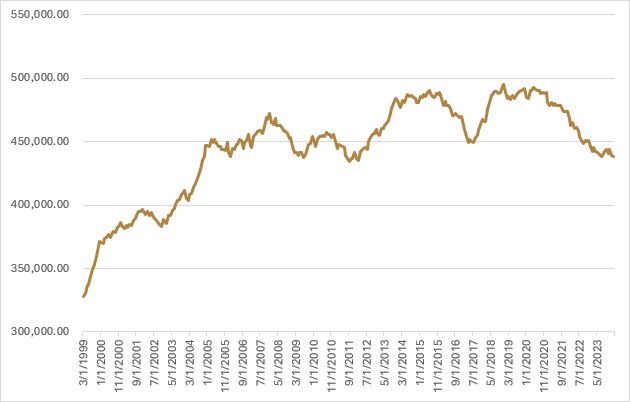Those with a sweet tooth breathed a sigh of relief yesterday as cocoa prices retreated from their nosebleed levels in the biggest one-day drop in 65 years. The violent collapse in prices sent the actively traded front month futures contract down -15.7%, effectively erasing most of the gains made in April. The meltdown was felt across the futures curve, though the contracts for next year’s main crop in March and May of 2025 weren’t as heavily impacted by the move, resulting in a bit of a flattening of the futures curve. As I highlighted last week, there have been some positive developments for mid-crop yields in West Africa with a more temperate climate, though a stronger mid-crop harvest is not enough by itself to solve the current supply shortage. The recent volatility from the massive upswing in prices has led to futures exchanges increasing margin requirements to hold cocoa futures, and we’re continuing to see non-commercial players decrease their exposure, which is potentially further exacerbating the already volatile price moves. With yesterday’s massive collapse, cocoa is running at annualized daily volatility of 60% since the beginning of 2024, and we expect there will be continued volatility until there is a meaningful supply-side response. While we don’t aim to forecast where supply and demand will ultimately find equilibrium, I do think prices will ultimately stabilize at a level higher than the 3k-4k/ton range we’ve seen over the last five years, and I wouldn’t be surprised to see prices come down into the $6k-7k range in the short term as the market corrects.

Regardless of any crystal-ball forecasts on short-term cocoa prices, a key takeaway here is how a position sizing framework that incorporates volatility can be beneficial to guard against sharp reversals like we saw yesterday. Throughout 2023, cocoa was running at an annualized daily volatility of just under 20%, and as noted above, volatility exploded as prices moved sharply higher in 2024. A position sizing methodology that aims to keep the risk contribution of a position stable within a portfolio would have been reducing the capital at risk as volatility of cocoa increased throughout 2024. This type of risk management approach to position sizing can be helpful to guard against sharp reversals by making sure your capital at risk does not inadvertently rise along with the underlying price, leaving you overconcentrated and overexposed.
While cocoa prices have hit an air pocket, copper prices are marching steadily higher as the long-term fundamental picture remains bullish. The copper concentrate market remains tight due to supply disruptions with mining operations in Peru, Panama, and Chile forcing smelters to pay up to secure supply and keep the lights on. Late last week, copper miner Codelco reported that output fell -9.6% relative to the first quarter of last year due to lower quality ore at their aging Chilean mines. This is further evidence that there hasn’t been the necessary investment in supply to keep up with demand. In fact, when looking at Chilean mined copper production, volumes have been on a steady decline since 2020.

As we spoke about in a note two weeks ago, treatment and refining charges that miners pay smelters to process raw material have been collapsing as ore supply has dwindled. The latest calculation from Fastmarkets it that treatment and refining charges have dropped from almost $50 per ton at the beginning of the year to just $0.10 per ton as of April 19th. Though it’s likely better for trading houses to secure supplies for their smelters and cover their variable costs than shuttering production altogether, these levels of treatment and refining charges seem unstainable over the long term. The futures curve being in contango may help to support some of the tightness in the concentrate market, with traders purchasing concentrate at narrow discounts, given that they can sell their refined production forward at prices in the future that are higher than spot. However, should refined supply start to wane from a decrease in smelter production, we could easily see the futures curve move from contango into backwardation.
Although the short-term fundamentals appear to be aligning with the longer-term bullish narrative that copper supply will be unable to keep up with demand from renewable energy and expanded power grids, the major industry announcement from last week highlights that prices might still not be high enough to entice miners into investing capital into new projects. The ongoing negotiation for a BHP Group takeover of Anglo American would, if approved, give BHP roughly 10% of global copper mine supply in an environment where copper ore is obviously tight. As Bloomberg reports, “this would be the first mega deal among the world’s biggest diversified miners in more than a decade,” though industry experts are forecasting that copper prices would have to reach $12k/ton (currently trading around $10k/ton) before miners would be confident in investing in projects to bring new supply on-line.
Happy investing!
Scott Smith
Chief Investment Officer
DISCLAIMER:
This blog and its contents are for informational purposes only. Information relating to investment approaches or individual investments should not be construed as advice or endorsement. Any views expressed in this blog were prepared based upon the information available at the time and are subject to change. All information is subject to possible correction. In no event shall Viewpoint Investment Partners Corporation be liable for any damages arising out of, or in any way connected with, the use or inability to use this blog appropriately.

